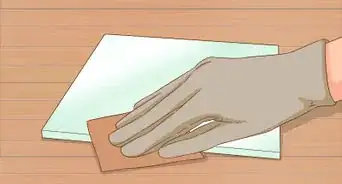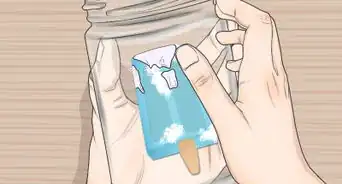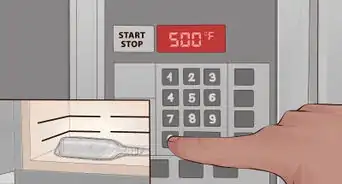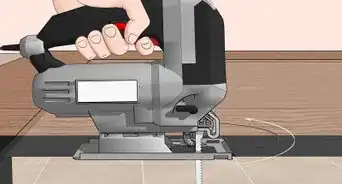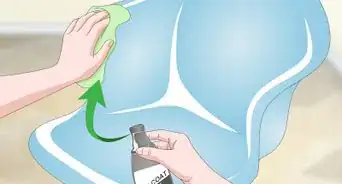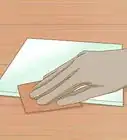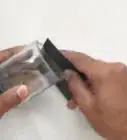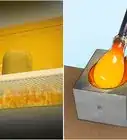wikiHow is a “wiki,” similar to Wikipedia, which means that many of our articles are co-written by multiple authors. To create this article, 55 people, some anonymous, worked to edit and improve it over time.
wikiHow marks an article as reader-approved once it receives enough positive feedback. This article received 19 testimonials and 91% of readers who voted found it helpful, earning it our reader-approved status.
This article has been viewed 1,647,416 times.
Learn more...
Whether setting a window pane, creating a stained glass mosaic, or doing some other project, cutting glass is a handy skill that isn't difficult to pick up. With the right tools and a steady hand, anyone can start cutting standard glass at home.
Steps
Preparation
-
1Set up your work area. You'll need a large flat surface, preferably one that is slightly soft and won't scratch your glass. Work in an area that is easy to clean.
- Avoid working over carpet because of the risk of getting glass shards on the floor if the glass breaks.
- For their own safety keep pets and children away from your workspace and materials.
-
2Clean the glass surface in the area where you plan to make cuts. Any grime or silica on the glass can ruin your score. Wipe these away by running a cloth or your finger along the surface of the glass where you plan to score.[1]Advertisement
-
3Obtain a glass cutter and some light oil. Glass cutters are about the size of a pencil and use a diamond or a hardened wheel to mark a score into glass so that it can be broken cleanly along a line. You can buy cutting oil at a stained glass store or use a small amount of kerosene.[2]
-
4Measure and mark where you want to score. The score must run from one edge of the glass to the other edge. You can write on the glass with a marker (preferably with a straight edge, if you are cutting a straight line. You can also mark on paper and place the glass on top of the paper.[3]
- Cut should not be very long. Scores longer than two feet have a high failure rate when breaking.
- Make sure your marks leave about six inches of glass on each side to grip and break. If you cut smaller pieces, you may need to use special tools, like pliers or a light hammer, to break off glass you can't get a hold of.
Scoring the Glass
-
1Dip the cutter in the oil and grasp it like a pencil. An oiled cutter creates a smoother score line. Make sure to look at the wheel and make sure it is lined up the way you want the glass to cut.
-
2Lay out a straight edge. Use a yardstick or a normal desk ruler. You need something that has a thick enough profile that it won't conflict with the wheel on the cutter.
-
3Apply pressure to the glass and you pull the cutter along the surface, rolling on the small carbide wheel. Listen for a smooth sound like ripping silk. A gritty sound means that you are pushing too hard or that you did not oil your cutter. The less sound you make, the better your score will be.
- If you push too hard (a very common mistake), your cut gets "hot," meaning that it snaps and pops.
- You are aiming to get a uniform score. If you are pressing too hard in one spot and perfectly in another, the glass will not break the way that you want it to. Microscopic imperfections in your score will cause your cut to go askew.[4]
-
4Run the cutter smoothly from one edge to the other. Do not run back and forth over the line if you miss a spot.
-
5Check your score. You want a score that is not popping and is barely visible, if you were to wipe the oil away. It should look like a small scratch, nothing more. Make sure it runs completely from one edge to the other.
Breaking and Smoothing
-
1Grasp each side of the cut carefully in your hands. Hold the glass as if you were trying to break a potato chip in half with two hands.
-
2Apply minor pressure from the wrist to break the glass along your score. Your elbows do not move. Simply twist your wrists (your right wrist will turn clockwise and your left will turn counterclockwise). Imagine that the score you made is half the depth of the glass and now you need to "open it up" by using the score as a weak spot. You're done as soon as you have two pieces of glass instead of the one you started with.
- When the glass breaks, it may simply start as a "run." If it only runs an inch or so, apply a little more twisting pressure and it will continue to run.
-
3Use fine sandpaper or a sharpening stone to remove the sharp edge. This edge will be where the vertical edge meets the horizontal surfaces. Not only does sanding reduce the chances of your being cut, but sanded glass is less likely to chip along the edges and has some added strength.
Cutting on a Curve
-
1Follow a pattern that connects to the edge. If you are cutting a freehand shape, make sure you are breaking along lines that run from edge to edge. Mark your lines with a marker or set your glass over your pattern.
-
2Use several straight lines to cut a sharp curve. You should be able to score along gentle curves normally with a steady hand. For tighter curves, make a series of marks that run along part of the curve and skew off at a tangent outside the piece you want.
-
3Flip the glass over and gently press on the center of your score from the backside. You will start a run this way. Follow the run with light pressure and you can watch the glass separate where you scored it. If your score is too close to the edge of a piece of glass, it may run to the edge instead of along your score because that is the easiest path for the run to take.
-
4Make some relief cuts to remove small pieces at a time instead of all at once. The smaller the relief cuts, the more accurate your cut will be. Grip smaller pieces with pliers to snap them off.[5]
-
5Smooth your curved edges using a glass router. This machine uses a spinning wheel with fine diamond chips as a grinder. Turn on the router and press your curve firmly against the grinder to smooth out your curve, then sand as normal.
Community Q&A
-
QuestionWould a glass cutter cut mother-of-pearl tiles?
 Community AnswerYou can cut any tiles you want with a glass-cutter. Just see it as a piece of glass, and when you've carried out the cut, place the handle of the glass-cutter exactly under the cut and press down firmly on both sides. The tile will break easily.
Community AnswerYou can cut any tiles you want with a glass-cutter. Just see it as a piece of glass, and when you've carried out the cut, place the handle of the glass-cutter exactly under the cut and press down firmly on both sides. The tile will break easily. -
QuestionIs cutting a mirror the same as glass, and why is using a lighter a good way to tell how old a mirror is?
 Community AnswerYes, a mirror is just a piece of glass, but cutting it requires a first step. A mirror is reflective because of the silver color coating on one side. This requires you to first cut the coating with a razor blade exactly on the line where your glass cut is going to be. If you don't do this first, the coating will peel at your cut and ruin your mirror.
Community AnswerYes, a mirror is just a piece of glass, but cutting it requires a first step. A mirror is reflective because of the silver color coating on one side. This requires you to first cut the coating with a razor blade exactly on the line where your glass cut is going to be. If you don't do this first, the coating will peel at your cut and ruin your mirror. -
QuestionAm I supposed to cut the backside of the mirror with the razor blade/glass cutter?
 Community AnswerNormally, yes. The only exception is for "front surface mirrors" and they are not common items.
Community AnswerNormally, yes. The only exception is for "front surface mirrors" and they are not common items.
Warnings
- Wear goggles. If the glass cracks irregularly a piece could shoot towards your face.⧼thumbs_response⧽
- If you apply a decent amount of pressure and nothing happens, stop. If the score is not sufficient, the glass can break at any point, including right into your hands.⧼thumbs_response⧽
- Wear gloves. Edges and points can be very sharp, so wear a heavy cloth or leather glove that fits snugly so you don't lose your dexterity.⧼thumbs_response⧽
- Clean your work area thoroughly to remove any bits of glass you might have created. Even if you can't see them, they can become embedded in your feet or hands and hurt.⧼thumbs_response⧽
- Exercise caution if you decide to use kerosene since it is toxic and can cause serious harm when swallowed or breathed in.[6]⧼thumbs_response⧽
References
- ↑ https://www.bobvila.com/articles/how-to-cut-glass/
- ↑ https://chatterglass.wordpress.com/2015/05/27/lubricate-your-cutter-wheel/
- ↑ https://www.popularmechanics.com/home/a26289680/how-to-cut-glass/
- ↑ https://www.freepatternsforstainedglass.com/cutting-glass.html
- ↑ https://jamesclear.com/inside-cuts
- ↑ https://medlineplus.gov/ency/article/002807.htm
About This Article
Before you cut glass, clean the surface of the glass, then measure and mark the area you want to score. Dip a glass cutter into oil and grasp it like a pencil, then carefully pull the cutter along the mark you made to score the glass. Hold the sheet of glass in your hands and carefully apply minor pressure from your wrists to break the glass along the score. Smooth the edges with fine sandpaper or a sharpening stone. For tips on cutting on a curve, keep reading!
